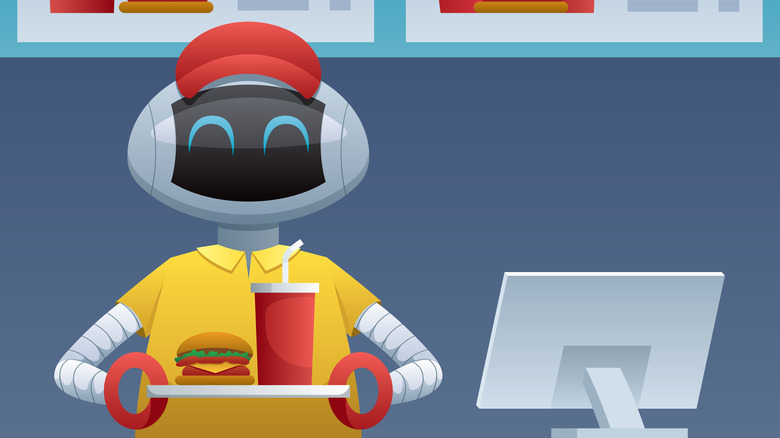The Labor Shortage Argument Behind The Rise Of AI Fast Food 'Workers'
Have you noticed a longer-than-usual wait at your favorite fast food chain or local restaurant? There's a reason why: a massive labor shortage. It's no secret that the COVID-19 pandemic had a major impact on the job market, with many employees leaving the workforce due to health concerns, taking early retirement, or assuming new family responsibilities. This has been especially obvious in the retail and food sectors, but artificial intelligence (AI) can potentially help fill the gap.
Many restaurants are already implementing AI technology to help ease the strains of the ongoing workforce shortage. These machines may not look like Rosey the Robot from the Jetsons cartoon, but they can do a lot to help keep a restaurant running, even if there are not enough human workers on staff. While some people see AI as the future of fast food and retail, others have concerns about how it's being used and what it means for exasperating the labor shortage issue.
The case for AI in fast food
For fast food, specifically, AI can help with the labor shortage issues and keep restaurants in business by taking on routine or repetitive tasks, freeing up human workers to focus on more complex work. This helps companies maintain productivity and saves time and money. Tasks like taking food orders and processing payments reduce the need for human cashiers, which can lower wait times and increase efficiency. This is particularly important during peak hours. These ordering kiosks can also provide personalized recommendations and upsell items, which can both increase customer satisfaction and sales for the restaurant.
AI-powered robots are being used to perform tasks such as slicing and dicing produce, monitoring inventory levels in real time, and making predictions about future demand. This ensures that restaurants have the right amount of ingredients and supplies on hand, which reduces waste and helps keep the kitchen running smoothly. And when it is time to deliver food, AI can also be used to optimize delivery routes, reducing delivery times.
Raising concerns about AI in fast food
There are several concerns about the use of AI in fast food, though. The main point is that it could lead to significant job losses. As companies adopt more automated systems and self-service kiosks, there may be fewer opportunities for human workers. This could have a significant impact on the economy and on workers who rely on these jobs. So, while robot workers can help with a labor shortage, they can also create higher unemployment.
If you think these issues don't directly affect you — think again. Another big concern about AI systems is that they may collect and store large amounts of data about customers, including their preferences and payment information. This opens customers up to possible data breaches. Plus, if the automated system is not properly designed or maintained, it could lead to errors in cooking or food storage that could impact the health and safety of customers. Finally, one concern that is already being realized is that AI simply cannot replace human interaction. This has left many customers unsatisfied with their fast food experience and demanding the return of human workers.


